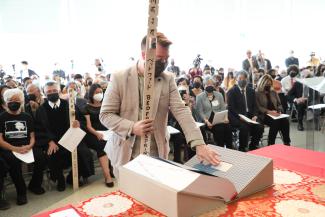
By ASAM professor Rob Buscher
Over the weekend of September 24 I had the opportunity to participate in an event held at the Japanese American National Museum in Los Angeles that commemorated each of the individuals who experienced the Japanese American wartime incarceration. Known as Irei or the National Monument for the World War II Japanese American Incarceration, the event was the culmination of several years of arduous labor by Buddhist scholar, Duncan Ryuken Williams, who serves as Director of the Shinso Ito Center for Japanese Religions and Culture at University of Southern California.
Williams previously wrote American Sutra, a seminal text that explores the role that Buddhism played in the forced removal and wartime incarceration of WWII. His latest project was a collaboration with the Japanese American National Museum to document for the first time in history a complete list of all persons of Japanese ancestry who were incarcerated during WWII. Although comprehensive records of the Japanese Americans incarcerated at the 10 War Relocation Authority camps (where the majority of Japanese Americans were held) exist, the government kept less organized accounts of the many Japanese nationals who were detained in Immigration and Naturalization Service centers, federal prisons, and Department of Justice facilities in regions throughout the country. This includes the 184 Japanese diplomats, consular officials, and their families who were detained at Bedford Springs Hotel in Western Pennsylvania from 1942-1945, who have previously been excluded from most lists of wartime incarcerees based on their nationality and circumstances of detention.
As a result of the Irei project, Duncan and his team at USC have documented the full extent of the wartime incarceration in the 75 sites they identified from across the country and have established a total count of 125,284 persons of Japanese ancestry. Their names have been documented on the Ireizo website and in a physical Ireicho (book of names) that was installed at the Japanese American National Museum on Saturday, September 24. Over the next year the book will remain at JANM where incarceration survivors, their descendants, and other interested participants can place a mark next to their names and other relations with a hanko (name seal). The book will then be toured across the country during the annual pilgrimage events held at each of the former incarceration sites.
As President of the civil rights group Japanese American Citizens League Philadelphia Chapter, I was invited to represent the Japanese American community of Pennsylvania during the installation ceremony. It was a profound honor to join together with individuals from around the country representing each of the wartime incarceration sites, among whom many were Japanese American scholars and community organizers who have greatly impacted my own work as both an academic and activist.
We marched in procession from the old Nishi Hongwanji Buddhist temple in Little Tokyo to the Japanese American National Museum carrying sotoba (wooden grave markers) with soil that we gathered from each of the sites. Prior to the ceremony, a small amount of the soil from each site was combined and processed into a clay slab that was fastened into the Ireicho book cover.
It was an incredible experience to represent our community in Pennsylvania, but what made it most significant on a personal level was that the procession departed from the temple that my family used to worship in before they were forcibly removed from their farm in the Greater Los Angeles region in the aftermath of the attack on Pearl Harbor. Although there is nothing that can take away the traumatic experiences that so many of their generation experienced, I would like to think that this monument may have given some sense of peace to the dwindling population of wartime incarceration survivors who still remain. It also allows descendants of the incarceration whose families have already passed on to make peace with these historic injustices and commemorate the struggles of their ancestors.
All in all, this experience reminded me that the past is never truly lost as historic events continue to ripple through time. Oftentimes past tragedies are politicized for dubious reasons, but this monument feels like an earnest attempt to achieve closure and heal the wounds of the past. I hope the Irei monument in all of its forms will have a similar impact on the public-at-large as our society continues to seek reconciliation amid the divisive times we are living in.
Video of the Ireicho installation procession
LA Times story on Ireicho
